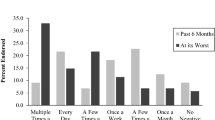Abstract
It is possible that autistic children are not neurophysiologically abnormal but children with hearing hyperacuity, born into an environment that cannot adapt to them. If so, to them, human sounds are not soothing but frightening. Environmental noises do not arouse curiosity but hurt so much the child withdraws. Because of self-imposed isolation, the child's brain hungers for stimulation, increasing the level of arousal which results in an anxietyevoking experience of sound in addition to pain. Parents mistake the withdrawal as a signal for them to try to communicate more vigorously thereby increasing the child's fear of them. Parents eventually learn to remain cool and aloof but this deprives the child of alternate forms of stimulation. The net result is an information-deprived brain, an inability to interpret auditory symbols and, eventually, irreversible retardation.
Similar content being viewed by others
References
Freedman N: A reliability study of psychiatric diagnosis in childhood and adolescence.J Child Psychol Psychiatry 12:43–54, 1971.
Churchill DW: The relation of infantile autism and early childhood schizophrenia to developmental language disorders of childhood.J Autism Child Schizo 2:182–197, 1972.
Ornitz EM: The modulation of sensory input and motor output in autistic children.J Autism Child Schizo 4:197–215, 1974.
Student M, Sohmer H: Evidence from auditory nerve and brainstem evoked response for an organic lesion in children with autistic traits.J Autism Child Schizo 8:13–29, 1978.
Condon WS: Multiple response to sound in dysfunctional children.J Autism Child Schizo 5:37–56, 1975.
Bender L, Freedman AM: A study of the first three years in the maturation of schizophrenic children.Q J Child Behav 4:245–272, 1952.
Wolff S, Chess S: An analysis of the language of fourteen schizophrenic children.J Child Psychol Psychiatry 6:29–41, 1965.
Rutt CN, Offord DR: Prenatal and perinatal complications in childhood schizophrenics and their siblings.J Nerv Ment Dis 152:324–331, 1971.
Takahashi S, Kanai H, Miyamoto Y: Reassessment of elevated seratonin levels in blood platelets in early infantile autism.J Autism Child Schizo 6:327–338, 1976.
Goldfarb W et al: A study of psychopathology of parents of psychotic children by structured interview.J Autism Child Schizo 6:327–338, 1976.
Bartak L, Rutter M, Cox A: A comparative study of autism and specific development receptive language disorder.Br J Psychiatry 126:127–145, 1975.
Boucher J: Articulation in early childhood autism.J Autism Child Schizo 6:297–302, 1976.
Cohen DJ et al: Primary childhood aphasia and childhood autism.J Am Acad Child Psychiatry 15:604–645, 1976.
Wallace BR: Negativism in verbal and non-verbal responses of autistic children.J Abnorm Psychol 84:138–143, 1975.
Lovaas OI, Berberick JP, Perloff BF, Shaeffer B: Aquisition of imitative speech by schizophrenic children.Science 151:705–707, 1966.
Ney PG: Operant conditioning of schizophrenic children.Can Psyciatr Assoc J 12:9–15, 1967.
Ney PG, Palvesky AE, Markely J: Relative effectiveness of operant conditioning and play therapy in childhood schizophrenia.J Autism Child Schizo 1:337–349, 1971.
DeMyer MK, Barton S, DeMyer WE, Norton JA, Allen J, Steel R: Prognosis in autism: a followup study.J Autism Child Schizo 3:199–205, 1973.
Myklebust H, Killen J, Bonnochie M: Emotional characteristics of learning disability.J Autism Child Schizo 2:151–162, 1972.
Hermelin B, O'Connor N: Spatial coding in normal, autistic and blind children.Percept Mot Skills 33:127–138, 1971.
Prior MR: Conditional matching learning set performance in autistic children.J Child Psychol Psychiatry 18:183–189, 1977.
Lockyer L, Rutter M: A five to fifteen years follow-up study of infantile psychosis.Br J Psychiatry 115:865–872.
Rachman S, Berger M: Whirling and postural control of schizophrenic children.J Child Psychol Psychiatry 4:137–142, 1963.
Ornitz EM, Brown MB, Mason A, Putnon NH: The effect of visual input on vestibular nystagmus in autistic children.Arch Gen Psychiatry 31:369–375, 1974.
Leach WW: Nystagmus: an integrative neural deficit in schizophrenia.J Abnorm Psychol 60:305–309, 1960.
Ornitz EM: Childhood autism, a review of the clinical and experimental literature.Calif Med J 118:21–47, 1973.
Richer JM, Coss RG: Gaze aversion in autistic and normal children.Acta Psychiatr Scand 53:193–210, 1976.
Hutt C, Forrest SJ, Richer J: Cardiac arrhythmia and behavior in autistic children.Acta Psychiatr Scand 51:136–372, 1975.
Tinbergen E, Tinbergen N.:Early Childhood Autism—An Ethological Approach. Berlin, Hildebrandt & Stephen, 1972.
Koegal RL et al: Identification of consistent responding to auditory stimuli by a functionally deaf autistic child.J Autism Child Schizo 6:147–156, 1976.
Ney, PG.Auditory hyperacuity in autistic children. Unpublished study, University of Illinois, Urbana, 1968.
Davis H: Average evoked response audiometry in North America.Acta Otolaryngol 65:79–86, 1968.
Hermelin B, O'Connor N: Effects of sensory input and sensory dominance on severely disturbed autistic children and on subnormal controls.Br J Psychol 55:241–256, 1964.
Cohen DJ et al: CSF biogenic amines in autistic and atypical children.Arch Gen Psychiatry 31:845–853, 1974.
Lorenz K: Man Meets Dog. London, Methuen & Co., 1955.
Russell TS:Threshold of hearing in children—some difficulties. In W. Taylor (Ed.),Disorder of Auditory Function. London, Academic Press, 1973.
Stephens SDG: Some personality factors influencing hearing. In W. Taylor (Ed.),Disorders of Auditory Function. London, Academic Press, 137–179, 1973.
Eagles EL, Wishik SM, Doerfler LG, Melnick W, Levine HS:Hearing Sensitivity and Related Factors in Children. Pittsburg, University of Pittsburg Press, 1963.
Ney PG: Four types of hyperkinesis.Can Psychiatr Assoc J 19:543–550, 1974.
Kolvin I: Psychosis in childhood: a comparative study. In M. Rutter (Ed.),Infantile Autism-Concepts, Characteristics and Treatment. London, Churchill, 7–26, 1971.
Ritvo ER et al: Correlation of psychiatric diagnosis and EEG findings: a double blind study of 184 hospitalized children.Am J Psychiatry 126:988–996, 1970.
Kameyama T et al: Effects of imipramine on auditory sensitivity in the rat in relation to initial sensitivity.Psychopharmacology 48:199–204, 1976.
Ney PG: Effect of contingent and non-contingent reinforcement on the behavior of an autistic child.J Autism Child Schizo 3:115–127, 1973.
McQuaid PE: Infantile autism in twins.Br J Psychiatry 127:530–534, 1975.
Rutter M, Lockyer L; A five to fifteen year follow-up study of infantile psychosis. I. Description of sample.Br J Psychiatry 113:1169–1182, 1967.
Ney PG, Lieh-Mak F, Cheng R. Chinese autistic children.J Soc Psyciatr, in press.
Author information
Authors and Affiliations
Rights and permissions
About this article
Cite this article
Ney, P.G. A psychopathogenesis of autism. Child Psych Hum Dev 9, 195–205 (1979). https://doi.org/10.1007/BF01433694
Issue Date:
DOI: https://doi.org/10.1007/BF01433694




